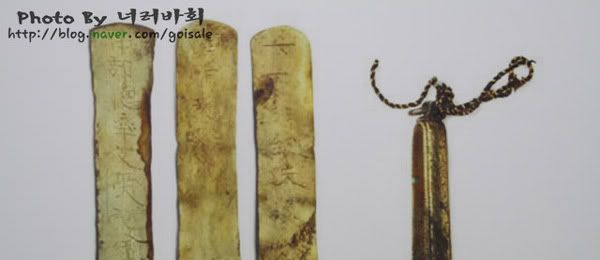Mireuksa: Two Months Later / "Cow Gold"
Earlier Mireuksa Posts: One | Two
Two months ago I wrote a pair of posts on a recent archaeological find at Mireuksa connected to a story from the Samguk Yusa. My first post was mentioned on the Korean meta-blog Hub of Sparkle last week, which was a bit surprising to see. (And here I thought kutay was the only one who reads my history-related updates.) Encountering a reference to my earlier entries made me realize that I hadn't checked for any recent information on whether archaeologists had been able to link Princess Seonhwa of Silla to Prince Seongdong of Baekje. With something like 500 artifacts recovered from the temple's cache it will obviously take some time to catalogue and analyze everything.
A recent search of Daum and Naver shows that Mireuksa made the news again last week, with articles coming from the Munhwa, Chosun, and Hankooki. However, the general feeling from each is that researchers are still no closer to finding a link than they were back in January. While browsing through Korean search engines I did come across another couple of sites with lovely photos. The first of is here courtesy of 9suk9suk while the second is a post here by 03swsw (사람♡사랑). The latter set includes two older images coming from 1910 and 1930 that add a little more historical context.
Another awesome find was this piece that discusses the currency and pressed gold in use by the Baekje kingdom at the time. From what I can make out it was common to emboss the hanja (Chinese character) for 'cow' (牛) on one edge of the gold, though I don't know the reasons for this. The Baekje kingdom wasn't founded on pastoralism and, if anything, I would expect the character for 'pig' to show up instead; I've heard from a few people that the Korean word for money (돈; don) is a homonym with the Korean pronunciation of the Chinese character for pig (豬) -- although Wiktionary has the pronunciation as something different (저; jeo).

Cow Gold. Image from goisale
By the way, kutay, I have a couple of archaeology-related .pdf articles about the temple if you're interested. One is in Korean, but you might be able to get some info out of the accompanying graphs and figures?
Two months ago I wrote a pair of posts on a recent archaeological find at Mireuksa connected to a story from the Samguk Yusa. My first post was mentioned on the Korean meta-blog Hub of Sparkle last week, which was a bit surprising to see. (And here I thought kutay was the only one who reads my history-related updates.) Encountering a reference to my earlier entries made me realize that I hadn't checked for any recent information on whether archaeologists had been able to link Princess Seonhwa of Silla to Prince Seongdong of Baekje. With something like 500 artifacts recovered from the temple's cache it will obviously take some time to catalogue and analyze everything.
A recent search of Daum and Naver shows that Mireuksa made the news again last week, with articles coming from the Munhwa, Chosun, and Hankooki. However, the general feeling from each is that researchers are still no closer to finding a link than they were back in January. While browsing through Korean search engines I did come across another couple of sites with lovely photos. The first of is here courtesy of 9suk9suk while the second is a post here by 03swsw (사람♡사랑). The latter set includes two older images coming from 1910 and 1930 that add a little more historical context.
Another awesome find was this piece that discusses the currency and pressed gold in use by the Baekje kingdom at the time. From what I can make out it was common to emboss the hanja (Chinese character) for 'cow' (牛) on one edge of the gold, though I don't know the reasons for this. The Baekje kingdom wasn't founded on pastoralism and, if anything, I would expect the character for 'pig' to show up instead; I've heard from a few people that the Korean word for money (돈; don) is a homonym with the Korean pronunciation of the Chinese character for pig (豬) -- although Wiktionary has the pronunciation as something different (저; jeo).

Cow Gold. Image from goisale
By the way, kutay, I have a couple of archaeology-related .pdf articles about the temple if you're interested. One is in Korean, but you might be able to get some info out of the accompanying graphs and figures?